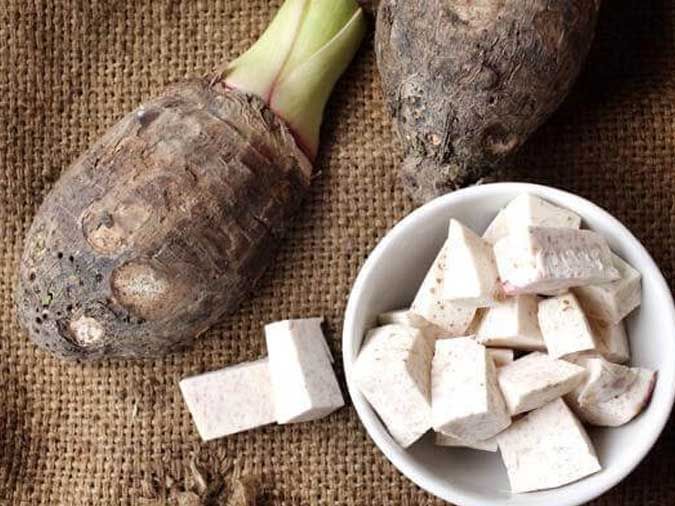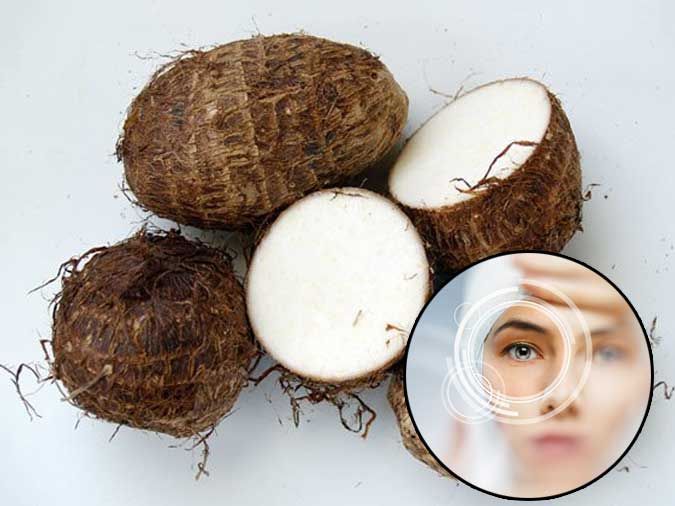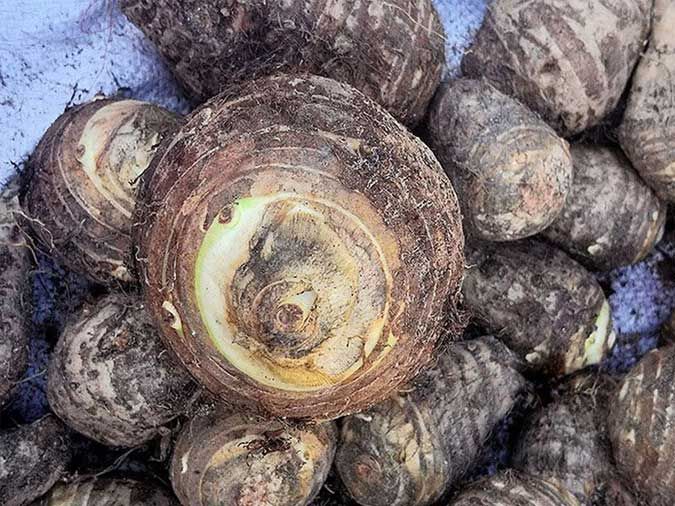Taro is a nutritious food, but taro also has many other health benefits that many people do not know about.
1. What is taro?
Taro is a starchy food grown widely in Asia, but is now popular around the world.
For Vietnamese people, taro is a fairly familiar tuber. The tuber has a brown skin, white flesh with transparent purple spots. When cooked, it has a fragrant aroma, a sweet, fatty taste and a texture similar to potatoes. Popular types of taro today include white taro, purple taro and yellow wax taro

Popular types of taro today
Many people often mistake taro and yam for the same thing, but in fact, the two tubers belong to the same species, Colocasia esculenta, and differ in a few ways: taro has many main tubers, the main tubers are about 1.4 – 2kg and very few small tubers, the skin of the taro is smooth brown, while taro has many small tubers, each tuber is only about the size of a fist, has long, thin hairs, and is light brown.
2. Effects of taro
Taro is an excellent source of fiber and other nutrients and brings many potential health benefits. Below are the health effects of taro when used:
2.1 Control blood sugar
Although taro is a starchy tuber, it contains 2 types of carbohydrates that are beneficial for controlling blood sugar: fiber and resistant starch.
Fiber is a type of carbohydrate that humans cannot digest, so it does not affect blood sugar levels. In addition, the fiber in taro also helps slow down the digestion and absorption of other types of carbs, preventing blood sugar spikes after eating.

Eating taro helps control blood sugar levels.
In addition, resistant starch in taro is also a type of nutrient that cannot be digested, so it does not increase blood sugar levels.
The combination of fiber and resistant starch makes taro a good choice for people with diabetes, as they can help regulate the release of insulin and glucose in the blood.
2.2 Reduce the risk of cardiovascular disease
Fiber and resistant starch in taro can also help reduce the risk of cardiovascular disease. Fiber and resistant starch both have the effect of reducing cholesterol in the body, which helps reduce the risk of cardiovascular problems.
Moreover, the potassium content in taro is also quite high, which is one of the essential minerals that maintain health and daily activities. Potassium not only facilitates the transport of fluids between membranes and tissues in the body, but also reduces tension and pressure on blood vessels and arteries, thereby helping to reduce blood pressure and stress on the cardiovascular system.
2.3 Helps lose weight
Because it contains a rich source of fiber, the effect of taro can help increase the feeling of fullness, reduce overall calories and increase fat burning. This has helped taro have the effect of losing weight and reducing body fat.
2.4 Stimulates digestion
One of the health benefits of taro is to stimulate digestive activity in the body, because taro contains a lot of resistant starch and fiber.
Both fiber and mineral starch are not digested or absorbed by the body, so they still exist in the intestines, becoming food for bacteria in the intestines, promoting the growth of beneficial bacteria, thereby helping your digestive system stay healthy.
In addition, the effects of taro also help prevent some problems such as flatulence, bloating, cramps, constipation and even diarrhea.
2.5 Preventing types of cancer
The effects of taro play an important role in antioxidant activity in the body and contribute to preventing cancer.
Taro has a high content of vitamin A, vitamin C, and taro has polyphenol antioxidants that help strengthen the immune system and remove dangerous free radicals from the body. Stem cells, if not removed, can turn into dangerous cancer cells.
Furthermore, taro contains cryptoxanthin which can prevent nasopharyngeal cancer and lung cancer.
2.6 Helps skin healthy and vibrant
Vitamin A, vitamin C and antioxidants in taro will help rejuvenate and fade skin blemishes. It can also fight free radicals, help skin healthy, anti-inflammatory and fade wrinkles.
2.7 Strengthen the immune system
One of the benefits of taro is providing an incredible amount of vitamin C, which can strengthen the immune system. Eating taro will help the body supplement a large amount of vitamins, helping the body fight disease, prevent common colds and flu.
2.8 Good for eye health
Taro contains antioxidants such as crytoxanthin and beta-carotene that can help enhance vision and improve eye health. These antioxidants have the ability to slow down the aging process of cells in the eyes, which are the cause of macular degeneration and cataracts.

Benefits of Taro for Eye Health
2.9 Improves Blood Circulation
Taro is rich in iron and copper, iron plays a role in preventing anemia and promoting blood circulation. In addition, taro also fights anemia symptoms such as headaches, fatigue and lack of concentration.
3. Can pregnant women eat taro?
Taro is a delicious tuber that can be boiled, cooked in soup, stewed with bones…. Therefore, it is used quite a lot in pregnant women’s dishes. Pregnant women eating taro can help provide many important nutrients for the body such as vitamins, folate, zinc, fiber or carbohydrates..
Thanks to the many nutrients provided, pregnant women who regularly consume taro will prevent constipation during pregnancy, laxative, prevent fetal malformations, limit gestational diabetes, prevent physical weakness and help beautify the skin.
However, pregnant women need to pay attention during the process of processing taro so as not to lose nutrients and absolutely do not keep the sprouts because they contain a lot of toxins that can easily lead to a high risk of poisoning.
4. What delicious dishes can be made with taro?
Taro contains a lot of starch and has a slightly sweet taste, so it is often used in sweet and savory dishes.

Taro can be processed into many delicious dishes.
Some popular ways to prepare taro include:
Fried taro (similar to French fries) or grilled
Steamed (boiled) taro
Baked taro cake
Fry taro with fish sauce
Used as an ingredient in soups and stews.
5. Harmful effects of taro
Although taro is good for health and is a nutritious food, it should only be eaten when cooked. Raw taro contains a small amount of protease and oxalate, two substances that can make your throat feel itchy and sore.
Consuming a lot of oxalate can lead to the formation of kidney stones. Therefore, when eating taro, you need to cook it thoroughly to easily prevent this.
Culinary experts say that taro should be cooked for about 45 minutes to 1 hour to destroy all harmful toxins.
6. How to choose delicious, quality taro
When choosing to buy taro, you don’t have to choose large tubers because they will be delicious, because if you don’t know how to choose, it will be easy to buy taro tubers that are hard and bad, wasting money and effort and not having a delicious dish.
In fact, choosing taro is quite simple, you just need to look at the shape, judge based on the weight, color, and texture of the potato to be able to choose a “standard” quality taro.

How to choose the right taro
In addition, you should also refer to how to preserve taro to help store them for a long time without spoiling or losing all nutrients when you want to process them.
7. Nutritional composition of taro
Taro contains a lot of nutritional components such as organic compounds, minerals and vitamins and a relatively high calorie content.
A cup of cooked taro (132gr) contains about 187 calories – mainly from carbs – and less than one gram each of protein and fat. In addition, with similar content, taro also contains the following substances:
Fiber: 6.7g
Manganese: 30% Daily Value (DV)
Vitamin B6: 22% DV
Vitamin E: 19% DV
Potassium: 18% DV
Copper: 13% DV
Vitamin C: 11% DV
Phosphorus: 10% DV
Magnesium: 10% DV
Thus, the effects of taro are very good for health and supplement essential nutrients for the body when used. Adding taro to your daily diet will provide essential nutrients for the body, thereby helping to supplement and prevent many diseases.





